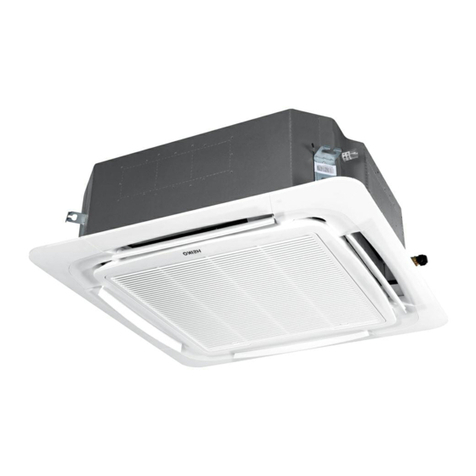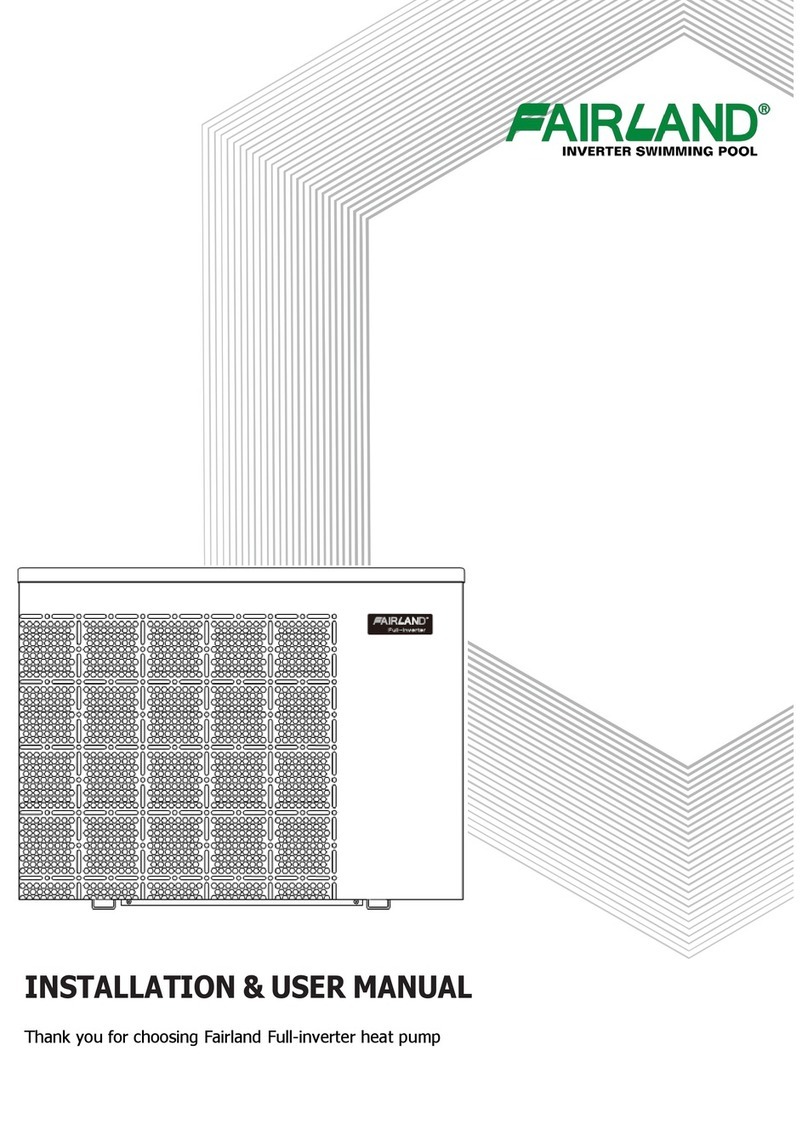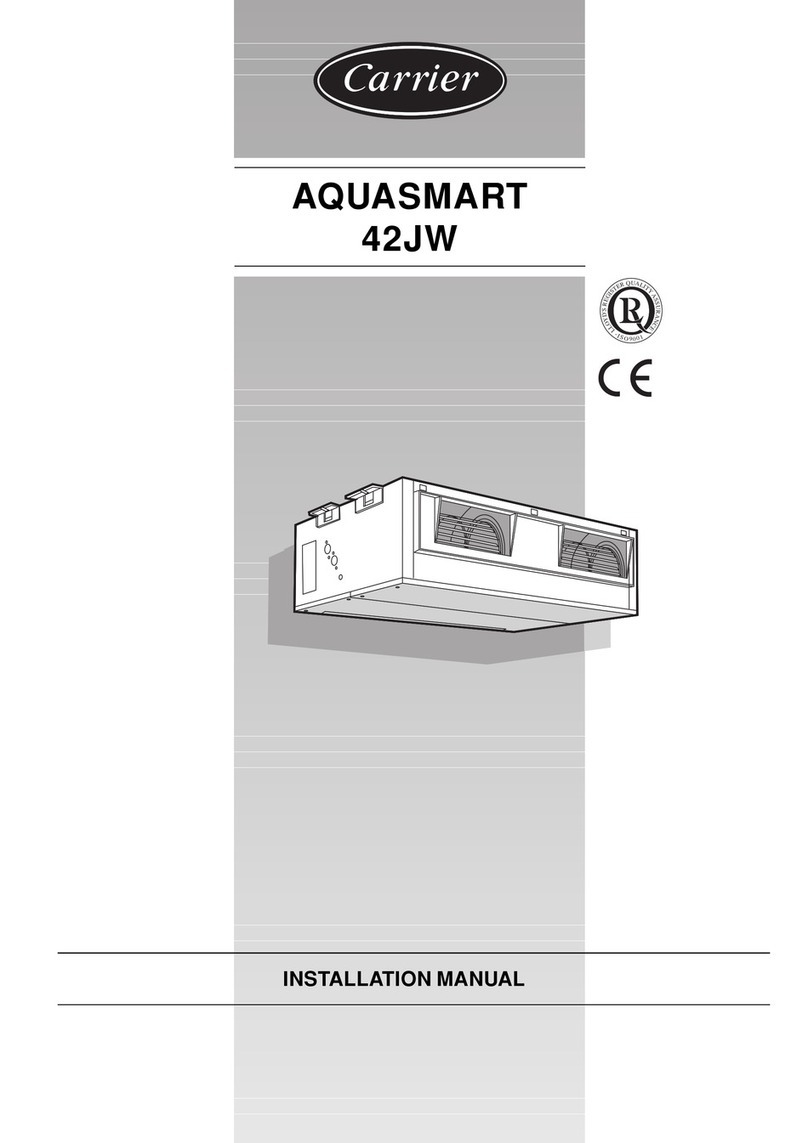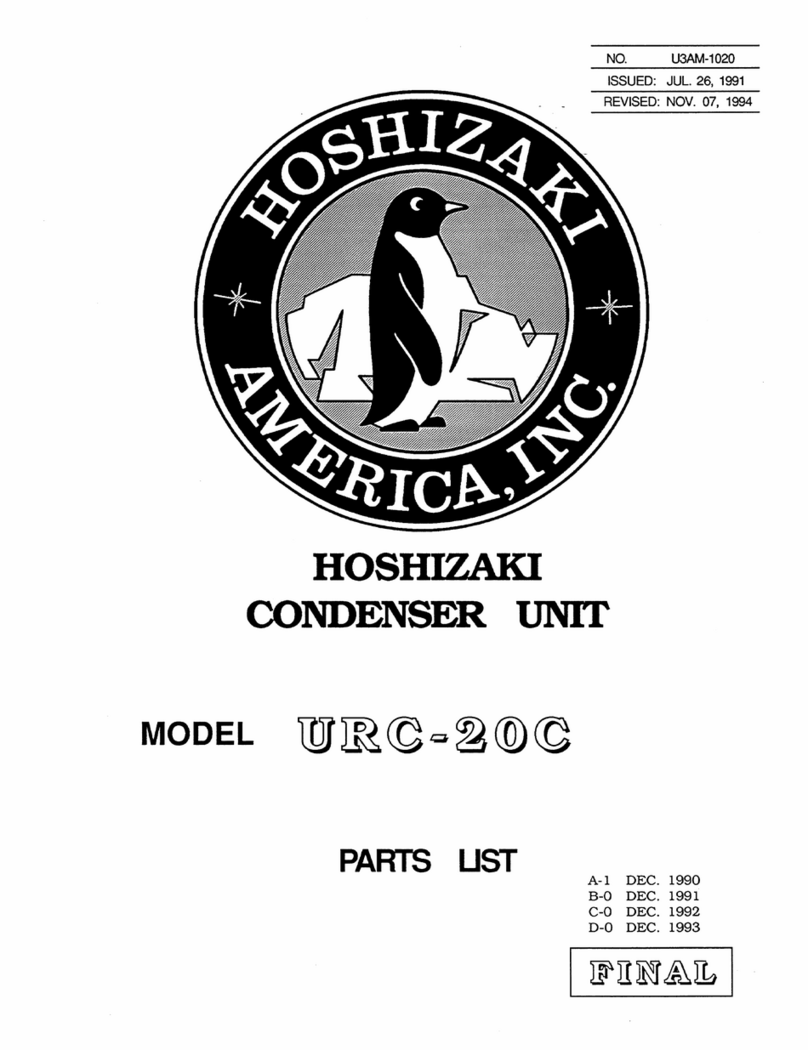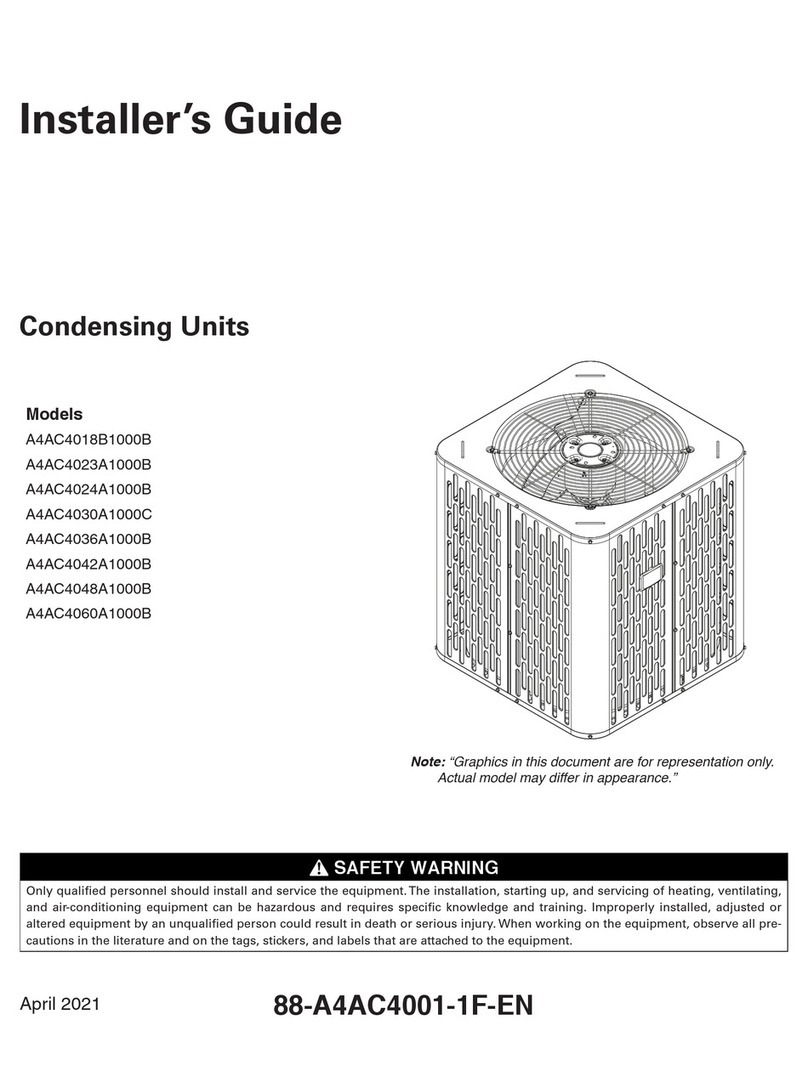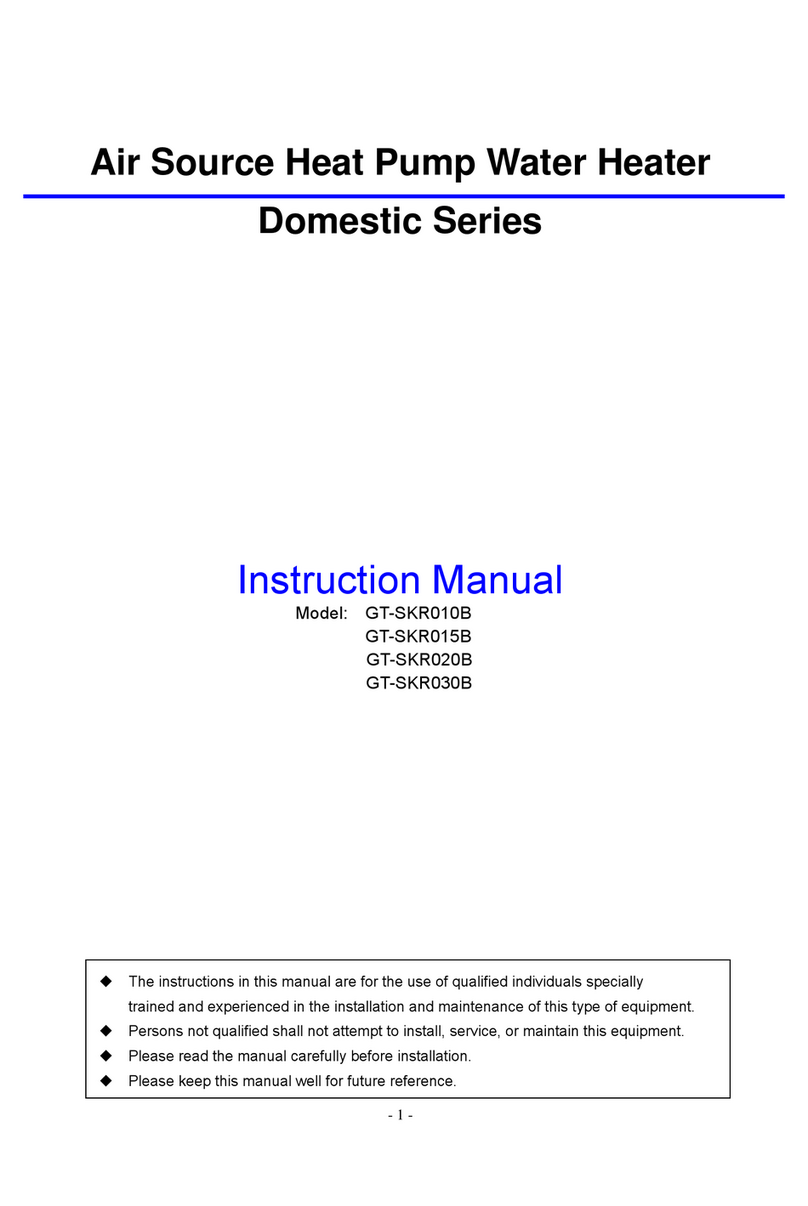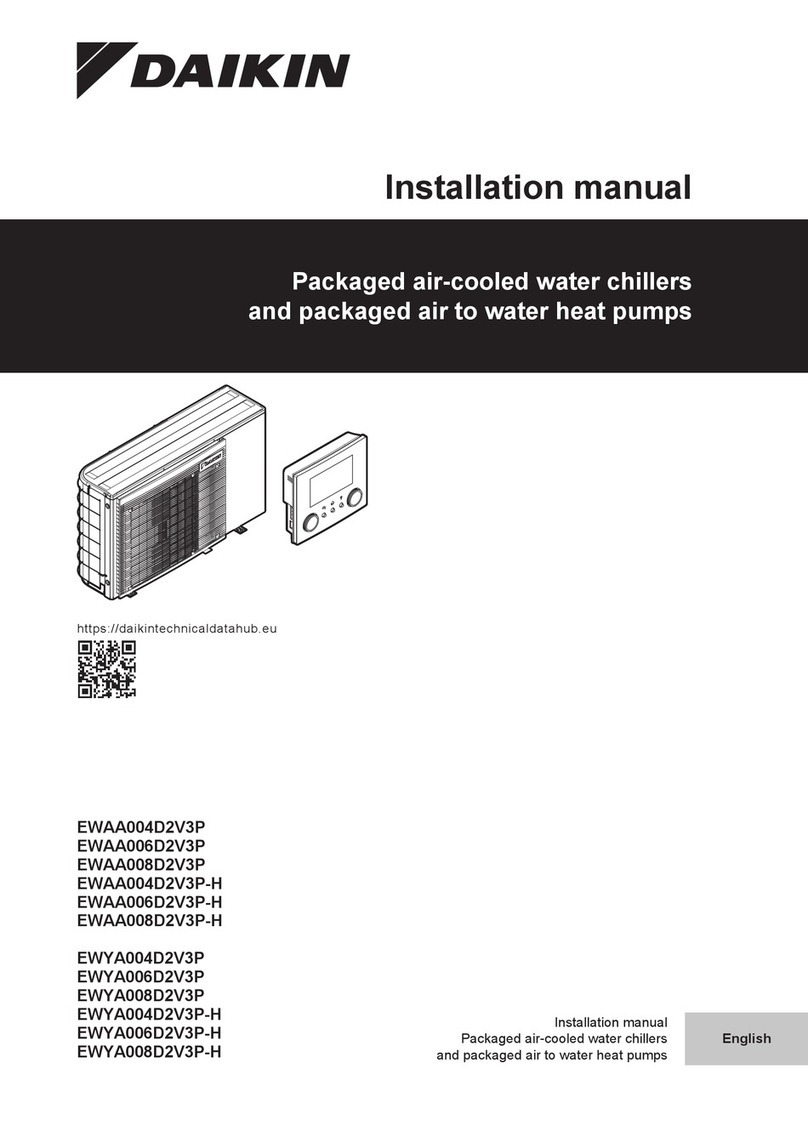Heiko Thermal 6 User manual

H
Heat Pump
DC Inverter Air to Water
Before operating this product, please read the
instructions carefully and keep this manual for future use.
This product may only be installed or serviced by
qualified personnel.
This appliance is filled with R32 refrigerant.
User’s manual
User’s manual
Thermal 6
Thermal 9
Thermal 12

2
2
1. Before use
1.1 Safety precautions
1.2 Working principle
1.3 Main components
1.4 Specifications
2. Assembly Configurations
1. Flowchart
2. Drawing 1
3. Drawing 2
4. Drawing 3
5. Drawing 4
6. Drawing 5
7. Drawing 6
8. Drawing 7
9. Drawing 8
10. Drawing 9
11. Drawing 10
3. Installation
3.2 Tools needed
3.3 Installation of the indoor control unit
3.4 Installation of the monoblock unit
3.5 Accessories
3.6 Wiring
3.7
3.8 Water pipe connection
3.9 Test run
4. Usage
4.1 Introduction of operation panel
4.2 Operation instruction
4.3 Electric heater
4.4 Failure codes
3.1 General application system introduction
Installation of safety valve kit
4
10
12
13
15
16
16
17
19
22
25
28
31
34
37
40
43
46
46
53
53
55
57
58
71
72
73
74
74
79
104
105
Catalogue

5. Maintenance
5.1 Precaution of maintenance for units with flammable refrigerant
5.2 Attention
5.6
5.7
5.8
6.
6.1 Outlines and dimensions
6.2 Exploded view
6.3 Wiring diagram
5.3 Cleaning of water filter
5.4 Cleaning of plate heat exchanger
5.5 Gas charging
Condenser coil
Service of indoor control unit
Service of monoblock unit
Attached drawing
6.4 Appendix A:Wiring
110
110
113
113
113
113
115
115
117
121
121
123
125
128
Catalogue
3

1. Before use
4
4
1.1 Safety precautions
Cautions:
1.Do not use means to accelerate the defrosting process or to clean,other than those recommended
by the manufacturer.
2.The appliance shall be stored in a room without continuously operating ignition sources
(for example: open flames, an operating gas appliance or an operating electric heater.).
3.Do not pierce or burn.
4.Be aware that refrigerants may not contain an odour.
5.Appliance shall be installed, operated and stored in a room with a floor area larger than X m2
(refer to specifications sheet).
6.The installation of pipe-work shall be kept to a minimum X m2 (refer to specifications sheet).
7.Spaces where refrigerant pipes shall be compliance with national gas regulations.
8.Servicing shall be performed only as recommended by the manufacturer.
9.The appliance shall be stored in a well-ventilated area where the room size corresponds to the room
area as specified for operation.
10.All working procedure that affets safety means shall only be carried by competent persons.
Gerneral Notice:
Transport of equipment containing flammable refrigerants
Compliance with the transport regulations
Marking of equipment using signs
Compliance with local regulations
Disposal of equipment using flammable refrigerants
Compliance with national regulations
Storage of equipment/appliances
The storage of equipment should be in accordance with the manufacturer’s instructions.
Storage of packed (unsold)quipment
Storage package protection should be constructed such that mechanical damage to the equipment
inside the package will not cause a leak of the refrigerant charge.
The maximum number of pieces of equipment permitted to be stored together will be determined
by local regulations.
Information on servicing
1)Checks to the area
Prior to beginning work on systems containing flammable refrigerants, safety checks are necessary
to ensure that the risk of ignition is minimised. For repair to the refrigerating system, the following
precautions shall be complied with prior to conducting work on the system.
Work procedure
Work shall be undertaken under a controlled procedure so as to minimise the risk of a flammable
gas or vapour being present while the work is being performed.
1.
2.
3.
4.
5.
6.
2)

1. Before use
5
5
3) General work area
All maintenance staff and others working in the local area shall be instructed on the nature of work
being carried out. Work in confined spaces shall be avoided. The area around the workspace shall
be sectioned off. Ensure that the conditions within the area have been made safe by control of
flammable material.
Checking for presence of refrigerant
The area shall be checked with an appropriate refrigerant detector prior to and during work, to
ensure the technician is aware of potentially flammable atmospheres. Ensure that the leak
detection equipment being used is suitable for use with flammable refrigerants, i.e. non-sparking,
adequately sealed or intrinsically safe.
Presence of fire extinguisher
If any hot work is to be conducted on the refrigeration equipment or any associated parts,
appropriate fire extinguishing equipment shall be available to hand. Have a dry powder
or CO2 fire extinguisher adjacent to the charging area.
No ignition sources
No person carrying out work in relation to a refrigeration system which involves exposing any
pipe work that contains or has contained flammable refrigerant shall use any sources of ignition
in such a manner that it may lead to the risk of fire or explosion. All possible ignition sources,
including cigarette smoking, should be kept sufficiently far away from the site of installation,
repairing, removing and disposal, during which flammable refrigerant can possibly be released
to the surrounding space. Prior to work taking place, the area around the equipment is to be
surveyed to make sure that there are no flammable hazards or ignition risks. No Smoking”
signs shall be displayed.
Ventilated area
Ensure that the area is in the open or that it is adequately ventilated before breaking into the
system or conducting any hot work. A degree of ventilation shall continue during the period
that the work is carried out. The ventilation should safely disperse any released refrigerant
and preferably expel it externally into the atmosphere.
Checks to the refrigeration equipment
Where electrical components are being changed, they shall be fit for the purpose and to the
correct specification. At all times the manufacturer’s maintenance and service guidelines
shall be followed. If in doubt consult the manufacturer’s technical department for assistance.
The following checks shall be applied to installations using flammable refrigerants:
-The charge size is in accordance with the room size within which the refrigerant containing
parts are installed;
The ventilation machinery and outlets are operating adequately and are not obstructed;
-If an indirect refrigerating circuit is being used, the secondary circuit shall be checked for
the presence of refrigerant;
Marking to the equipment continues to be visible and legible. Markings and signs that are
illegible shall be corrected;
Refrigeration pipe or components are installed in a position where they are unlikely to be
exposed to any substance which may corrode refrigerant containing components, unless the
components are constructed of materials which are inherently resistant to being corroded or
are suitably protected against being so corroded.
4)
5)
6)
“
7)
8)
-
-
-

1. Before use
6
6
9) Checks to electrical devices
Repair and maintenance to electrical components shall include initial safety checks and component
inspection procedures. If a fault exists that could compromise safety, then no electrical supply shall
be connected to the circuit until it is satisfactorily dealt with. If the fault cannot be corrected
immediately but it is necessary to continue operation, an adequate temporary solution shall be used.
This shall be reported to the owner of the equipment so all parties are advised.
Initial safety checks shall include:
.That capacitors are discharged: this shall be done in a safe manner to avoid possibility of sparking;
That there no live electrical components and wiring are exposed while charging, recovering or
purging the system;
That there is continuity of earth bonding.
.
.
7.Repairs to sealed components
During repairs to sealed components, all electrical supplies shall be disconnected from the
equipment being worked upon prior to any removal of sealed covers, etc. If it isabsolutely
necessary to have an electrical supply to equipment during servicing, then a permanently
operating form of leak detection shall be located at the most critical point to warn of a
potentially hazardous situation.
Particular attention shall be paid to the following to ensure that by working on electrical
components, the casing is not altered in such a way that the level of protection is affected.
This shall include damage to cables, excessive number of connections, terminals not made
to original specification, damage to seals, incorrect fitting of glands, etc.
Ensure that apparatus is mounted securely.
Ensure that seals or sealing materials have not degraded such that they no longer serve the
purpose of preventing the ingress of flammable atmospheres. Replacement parts shall be
in accordance with the manufacturer’s specifications.
NOTE: The use of silicon sealant may inhibit the effectiveness of some types of leak detection
equipment. Intrinsically safe components do not have to be isolated prior to working on them.
1)
2)
8.Repair to intrinsically safe components
Do not apply any permanent inductive or capacitance loads to the circuit without ensuring that
this will not exceed the permissible voltage and current permitted for the equipment in use.
Intrinsically safe components are the only types that can be worked on while live in the presence
of a flammable atmosphere.The test apparatus shall be at the correct rating.
Replace components only with parts specified by the manufacturer. Other parts may result in the
ignition of refrigerant in the atmosphere from a leak.

1. Before use
7
7
9.Cabling
Check that cabling will not be subject to wear,corrosion, excessive pressure, vibration,
sharp edges or any other adverse environmental effects. The check shall also take into
account the effects of aging or continual vibration from sources such as compressors or fans.
10.Detection of flammable refrigerants
Under no circumstances shall potential sources of ignition be used in the searching for or
detection of refrigerant leaks. A halide torch (or any other detector using a naked flame)
shall not be used.
11.Leak detection methods
The following leak detection methods are deemed acceptable for systems containing
flammable refrigerants.
Electronic leak detectors shall be used to detect flammable refrigerants, but the sensitivity
may not be adequate, or may need re-calibration. (Detection equipment shall be calibrated
in a refrigerant-free area.) Ensure that the detector is not a potential source of ignition and is
suitable for the refrigerant used. Leak detection equipment shall be set at a percentage of the
LFL of the refrigerant and shall be calibrated to the refrigerant employed and the appropriate
percentage of gas (25% maximum) is confirmed.
Leak detection fluids are suitable for use with most refrigerants but the use of detergents
containing chlorine shall be avoided as the chlorine may react with the refrigerant and corrode
the copper pipe-work.
If a leak is suspected, all naked flames shall be removed/ extinguished.
If a leakage of refrigerant is found which requires brazing, all of the refrigerant shall be recovered
from the system, or isolated (by means of shut off valves) in a part of the system remote from the leak.
Oxygen free nitrogen (OFN) shall then be purged through the system both before and during the
brazing process.
12.Removal and evacuation
When breaking into the refrigerant circuit to make repairs – or for any other purpose –conventional
procedures shall be used. However, it is important that best practice is followed since flammability
is a consideration. The following procedure shall be adhered to:
• Remove refrigerant;
• Purge the circuit with inert gas;
• Evacuate;
• Purge again with inert gas;
• Open the circuit by cutting or brazing.
The refrigerant charge shall be recovered into the correct recovery cylinders. The system shall
be “flushed” with OFN to render the unit safe. This process may need to be repeated several times.
Compressed air or oxygen shall not be used for this task.
Flushing shall be achieved by breaking the vacuum in the system with OFN and continuing to fill
until the working pressure is achieved, then venting to atmosphere, and finally pulling down to a
vacuum. This process shall be repeated until no refrigerant is within the system. When the final
OFN charge is used, the system shall be vented down to atmospheric pressure to enable work to
take place. This operation is absolutely vital if brazing operations on the pipe-work are to take place.
Ensure that the outlet for the vacuum pump is not close to any ignition sources and there is
ventilation available.

1. Before use
8
8
13.Charging procedures
In addition to conventional charging procedures, the following requirements shall be followed.
– Ensure that contamination of different refrigerants does not occur when using charging equipment.
Hoses or lines shall be as short as possible to minimise the amount of refrigerant contained in them.
– Cylinders shall be kept upright.
– Ensure that the refrigeration system is earthed prior to charging the system with refrigerant.
– Label the system when charging is complete (if not already).
– Extreme care shall be taken not to overfill the refrigeration system.
Prior to recharging the system it shall be pressure tested with OFN. The system shall be leak tested
on completion of charging but prior to commissioning. A follow up leak test shall be carried out
prior to leaving the site.
14.Decommissioning
Before carrying out this procedure, it is essential that the technician is completely familiar with the
equipment and all its detail. It is recommended good practice that all refrigerants are recovered safely.
Prior to the task being carried out, an oil and refrigerant sample shall be taken in case analysis is
required prior to re-use of reclaimed refrigerant. It is essential that electrical power is available before
the task is commenced.
a) Become familiar with the equipment and its operation.
b) Isolate system electrically.
c) Before attempting the procedure ensure that:
Mechanical handling equipment is available, if required, for handling refrigerant cylinders;
All personal protective equipment is available and being used correctly;
The recovery process is supervised at all times by a competent person;
.Recovery equipment and cylinders conform to the appropriate standards.
d) Pump down refrigerant system, if possible.
If a vacuum is not possible, make a manifold so that refrigerant can be removed from various
parts of the system.
Make sure that cylinder is situated on the scales before recovery takes place.
Start the recovery machine and operate in accordance with manufacturer’s instructions.
Do not overfill cylinders. (No more than 80%volume liquid charge).
Do not exceed the maximum working pressure of the cylinder, even temporarily.
When the cylinders have been filled correctly and the process completed, make sure that the
cylinders and the equipment are removed from site promptly and all isolation valves on the
equipment are closed off.
Recovered refrigerant shall not be charged into another refrigeration system unless it has
been cleaned and checked.
15.Labelling
Equipment shall be labelled stating that it has been de-commissioned and emptied of refrigerant.
The label shall be dated and signed. Ensure that there are labels on the equipment stating the
equipment contains flammable refrigerant.
16.Recovery
When removing refrigerant from a system, either for servicing or decommissioning, it is
recommended good practice that all refrigerants are removed safely.
When transferring refrigerant into cylinders, ensure that only appropriate refrigerant
recovery cylinders are employed. Ensure that the correct number of cylinders for holding
.
.
.
e)
f)
g)
h)
I)
j)
k)

1. Before use
9
9
the total system charge is available. All cylinders to be used are designated for the recovered
refrigerant and labelled for that refrigerant (i.e. special cylinders for the recovery of refrigerant).
Cylinders shall be complete with pressure relief valve and associated shut-off valves in good working
order. Empty recovery cylinders are evacuated and, if possible, cooled before recovery occurs.
The recovery equipment shall be in good working order with a set of instructions concerning the
equipment that is at hand and shall be suitable for the recovery of flammable refrigerants. In addition,
a set of calibrated weighing scales shall be available and in good working order. Hoses shall be complete
with leak-free disconnect couplings and in good condition. Before using the recovery machine,
check that it is in satisfactory working order, has been properly maintained and that any associated
electrical components are sealed to prevent ignition in the event of a refrigerant release.
Consult manufacturer if in doubt.
The recovered refrigerant shall be returned to the refrigerant supplier in the correct recovery cylinder,
and the relevant Waste Transfer Note arranged. Do not mix refrigerants in recovery units and especially
not in cylinders.
If compressors or compressor oils are to be removed, ensure that they have been evacuated to an
acceptable level to make certain that flammable refrigerant does not remain within the lubricant. The
evacuation process shall be carried out prior to returning the compressor to the suppliers. Only electric
heating to the compressor body shall be employed to accelerate this process. When oil is drained from
a system, it shall be carried out safely.
The unit contains fluorinated greenhouse gases. The refrigerant must not be released into the air!
All products comply with the following EU regulations:
Low Voltage Directive, Electromagnetic Compatibility.

1. Before use
CautionWarning Prohibition
1.2 Safety precautions
The following symbols are very important. Please be sure to understand their meaning, which concerns
the product and your personal safety.
The installation, dismantlement
and maintenance of the unit must
be performed by qualified
personnel. It is forbidden to do any
changes to the structure of the unit.
Otherwise injury of person or unit
damage might happen.
To avoid electrical shock, make
sure to disconnect the power
supply 1 minute or more before
servicing the electrical parts. Even
after 1 minute, always measure the
voltage at the terminals of main
circuit capacitors or electrical parts
and, before touching, make sure
that those voltages are lower
than the safety voltage.
User Manual
Be sure to read this manual before
use.
For sanitary hot water, please
always add a mixture valve before
water tap and set it to proper
temperature.
Ground wire
Use a dedicated socket for this
unit, otherwise malfunction may
occur.
The power supply to the unit must
be grounded.
Do not touch the air outlet grill
when fan motor is running.
Do not touch the power plug with
wet hands. Never pull out the plug
by pulling the power cable.
Do not operate your air conditioner
in a wet room such as a bathroom
or laundry room.Water or any kind
of liquid is strictly forbidden to be
poured into the product, or may
cause electric creepage or
breakdown of the product.
This appliance can be used by children aged from 8 years and above
and persons with reduced physical, sensory or mental capabilities or
lack of experience and knowledge if they have been given supervision
or instruction concerning use of the appliance in a safe way and
understand the hazards involved. Children shall not play with the
appliance. Cleaning and user maintenance shall not be made by
children without supervision.
10

1. Before use
Copper
Steel
Fuse
Main
Power Cable RCD
Indoor
control
unit
If the supply cord is damaged, it
must be replaced by the
manufacturer, its service agent or
similarly qualified persons in order
to avoid a hazard.
It is mandatory to use a suitable
circuit breaker for the heat pump
and make sure the power supply to
the unit corresponds to the
specifications. Otherwise the unit
might be damaged.
Disposal of Scrap Batteries(if
there is).Please discard the
batteries as sorted municipal waste
at the accessible collection point.
An all-pole disconnection device
which has at least 3mm clearances
in all poles , and have a leakage
current that may exceed 10mA,
the residual current device (RCD)
having a rated residual operating
current not exceeding 30mA, and
disconnection must be incorporated
in the fixed wiring in accordance
with the wiring rules.
ON
OFF
Please select the correct fuse or
breaker as per recommended. Steel
wire or copper wire cannot be
taken as substitute for fuse or
breaker. Otherwise, damages
maybe caused.
Be aware fingers might be hurt by
the fin of the coil.
11
This marking indicates that this product should not be disposed with
other household wastes throughout the EU. To prevent possible harm to
the environment or human health from uncontrolled waste disposal,
recycle it responsibly to promote the sustainable reuse of material
resources. To return your used device, please use the return and
collection systems or contact the retailer where the product was
purchased. They can take this product for environmental safe recycling.
System water filling T/P valve
Connect to heating/cooling system
Buffer tank
Connect to heat pump
One way valve
Filter
City water inlet
1. It's suggested to use pure water for filling the system.
2. If use city water for filling, please soften the water and add a filter.
Note: After filling, the system of water system should be 0.15~0.6MPa.

1.3 Working principle
1. Before use
Water inlet
Water Outlet
Filter
Water pump
Heat
exchanger
Power supply
Four-way vavle
Compressor
Three-way valve
Refrigerant Filter T-connector
Fan motor
Pressure
check valve
Evaporator
Heating
Cooling
12

1.4 Main components
1. Before use
1.4.1 Indoor control unit
1
13
Safety valve kit
Thermal 6/9/12
Cable gland
Operation panel
Water outlet 1
Water outlet 2
Water inlet
Electric box cover
Door
Water pump
Electric heater
Water pump

1.4.2 Monoblock unit
1. Before use
1
14
Thermal 6/9/12
Thermal 6
GWP: 675: 0,61 tonnes equivalent CO2, refrigant/quantity: R32/0,9kg
Thermal 9
GWP: 675: 0,95 tonnes equivalent CO2, refrigant/quantity: R32/1,4kg.
Thermal 12
GWP: 675: 1,22 tonnes equivalent CO2, refrigant/quantity: R32/1,8kg.

1.5 Specifications
1
15
1. Before use
Thermal 6 Thermal 9 Thermal 12
Note: (1) Heating condition: water inlet/outlet temperature: 30℃/35℃, Ambient temperature: DB 7℃/WB 6℃;
Heating condition: water inlet/outlet temperature: 40℃/45℃, Ambient temperature: DB 7℃/WB 6℃;
Cooling condition: water inlet/outlet temperature: 23℃/18℃, Ambient temperature: DB 35℃/WB 24℃;
Cooling condition: water inlet/outlet temperature: 12℃/7℃, Ambient temperature: DB 35℃/WB 24℃;
The specifications are subject to change without prior notice. For actual specifications of unit, please refer to the stickers on the unit.
(2)
(3)
(4)
(5)

1
16
2. Assembly Configurations - Flowchart
Locate the Configuration that Meets Your Needs
Follow the flowchart on
the right in order to locate
which of the assembly
configuration matches the
needs of the end user,
each of which contains
specific assembly and
wiring diagrams, with
software instructions.
Beginning from the green
“Start Here” bubble,
follow the appropriate
arrows to each question,
which are dependent on
the needs of the user.
The corresponding
assembly instructions will
be found by turning to the
page number in the end
bubble.
Note: The instructions in this
section are meant to achieve
the minimum requirements for
successful system operation
only.
For more in-depth settings
explanations, please refer to
the user′s manual.

1
17
2. Assembly Configurations - Drawing 1
Notice: The Fan Coil Unit,
Floor Heating System, and
Radiator are placeholder
distribution systems only
and can be substituted by
any other appropriate
distribution systems.
Please ensure that the
configuration matches the
assembly drawing depicted
on the right for a one
temperature zone without
domestic hot water setup.
Note: Refer to the next page for
wiring and software
operation instructions.
Name Symbol Name Symbol
Temp.Sensor
Safety valve Kit
Ball valve
Water filter
Air purging valve
Water pump
Mixing valve
Motorized valve
Expansion tank
Note:Dotted lines mean〝able to be controlled by the Heat Pump〞.
One Temperature Zone ,without DHW

1
18
2. Assembly Configurations - Drawing 1
Assembly 1: Wiring Diagram
To achieve successful operation at a minimum, ensure the ports below are properly connected.
Software: Basic Settings
1.Set the needed working modes of the unit via the menu
H.2. If no heating curve is desired:
3.Locate and activate the buffer tank and appropriate pumps under
H.1.Setting a heating curve:
H.Configuring the set water heating temperatures:
2.Temperature configuration options for Heating/Cooling circuit 1 are found under
C.Configuring the set water cooling temperature (if applicable):

1
19
2. Assembly Configurations - Drawing 2
Notice: The Fan Coil Unit,
Floor Heating System, and
Radiator are placeholder
distribution systems only
and can be substituted by
any other appropriate
distribution systems.
Please ensure that the
configuration matches the
assembly drawing depicted
on the right for a one
temperature zone without
domestic hot water setup,
that includes a component
circuit capable of heating or
cooling only,through the use
of a two-way motorized
valve.
Note: For the cooling-only or
heating-only circuit, a
motorized two-way valve
can be connected to the
unit, to cut the water
supply during heating or
cooling operation.
Refer to the next page for
wiring and software
operation instructions.
Name Symbol Name Symbol
Temp.Sensor
Safety valve Kit
Ball valve
Water filter
Air purging valve
Water pump
Mixing valve
Motorized valve
Expansion tank
Note:Dotted lines mean〝able to be controlled by the Heat Pump〞.
One Temperature Zone ,without DHW,with a heating-only
(or cooling-only) circuit,by usage of a motorized 2-way valve

2
20
2. Assembly Configurations - Drawing 2
Assembly 2: Wiring Diagram
To achieve successful operation at a minimum, ensure the ports below are properly connected.
Software: Basic Settings
1.Set the needed working modes of the unit via the menu
H.2. If no heating curve is desired:
3.Locate and activate the buffer tank and appropriate pumps under
H.1.Setting a heating curve:
H.Configuring the set water heating temperatures:
2.Temperature configuration options for Heating/Cooling circuit 1 are found under
C.Configuring the set water cooling temperature (if applicable):
Other manuals for Thermal 6
1
This manual suits for next models
2
Other Heiko Heat Pump manuals
Popular Heat Pump manuals by other brands

Dimplex
Dimplex WI 140TUR+ Installation and operating insctructions

Daikin
Daikin EMRQ8ABY1 installation manual
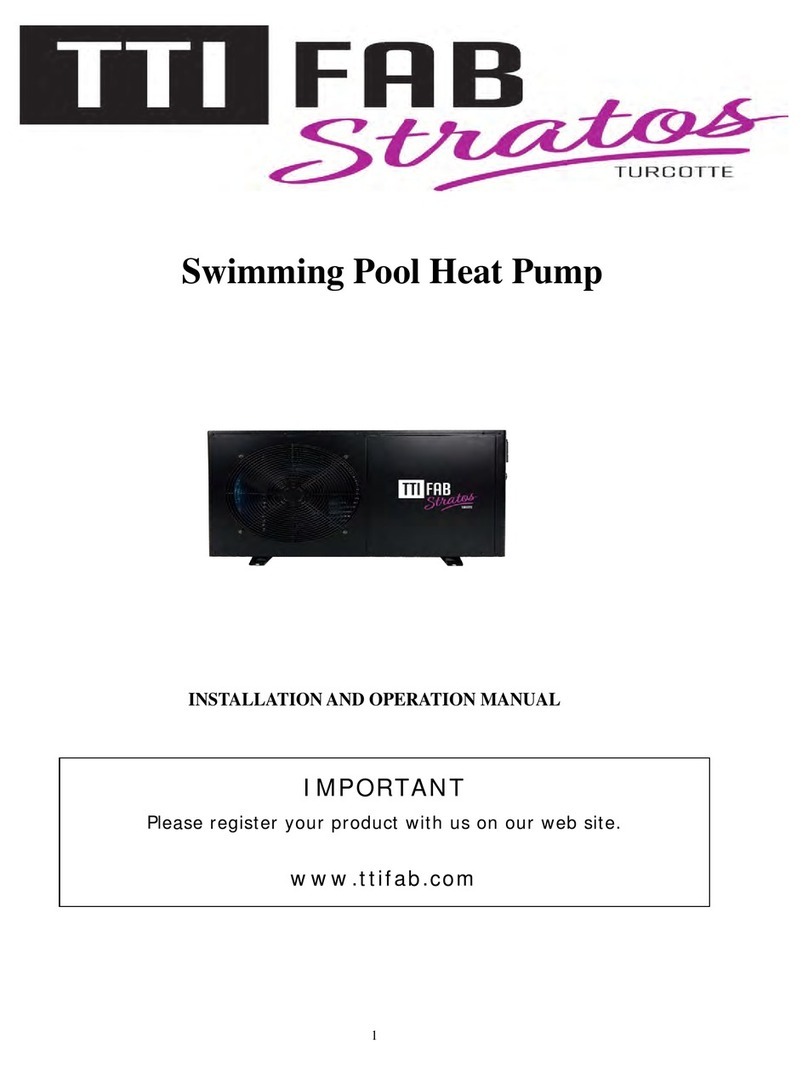
TTI FABRICATION
TTI FABRICATION STRATOS 40 Installation and operation manual

Miami Heat Pump
Miami Heat Pump HPX Series Installation guide & owner's manual

Hitachi
Hitachi YUTAKI S Series Installation and operation manual

AERMEC
AERMEC VXT R410A Technical manual installation maintenance



